The invention of the printing press created a revolution for Jews everywhere. Who could imagine at that time the extraordinary benefits that printing would bring to world Jewry? “People of the Book” vividly describes the invention itself, and then takes us through five hundred years of Hebrew printing, from the earliest products of fifteenth-century printers to those of modern times. Author and teacher Akiva Aaronson introduces us to the first printed editions of the classic sefarim: Talmud, Rambam, Arba’ah Turim, Shulchan Aruch, and many more. Meet the famous Hebrew printers of previous generations: Soncino, Bomber, Romm, Heidenheim, Bak and others. Visit the Jewish communities where Hebrew printing took place, from its earliest days until the present: Venice, Salonika, Prague, Amsterdam, Slavita, Warsaw and Vilna, to name a few. Weaving lively text with over two hundred magnificent, full-color photographs of original Hebrew volumes, “People of the Book” is truly a journey through time- Jewish time- over five centuries of Hebrew printing. Follow its odyssey, from persecution and censorship to survival and triumph, set against the phenomenal history of the times in this beautiful coffee-table edition.
Read more about Rabbi Aaronson's work here: www.akiva-aaronson.com
Click here to listen to author Rabbi Akiva Aaronson speak about "The First Hebrew Printers: Challenges, Triumphs, and Halachic Questions” – from lecture in London, UK May 27, 2014.
Click on images below to read reviews of this book






Read more about Rabbi Aaronson's work here: www.akiva-aaronson.com
Click here to listen to author Rabbi Akiva Aaronson speak about "The First Hebrew Printers: Challenges, Triumphs, and Halachic Questions” – from lecture in London, UK May 27, 2014.
Click on images below to read reviews of this book
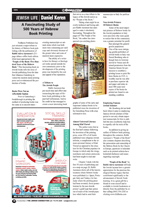
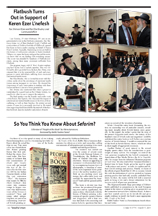
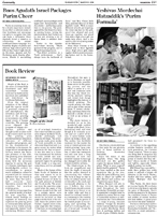
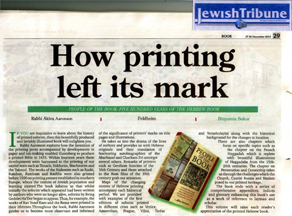
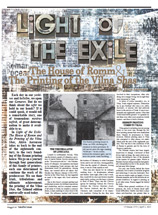
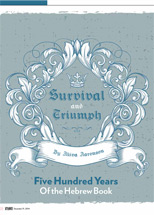
| Dimensions | 9" x 11.7" |
|---|---|
| ISBN | 978-159826956-7 |
| Publisher | Feldheim Publishers |
| Number of pages | 231 |
| Item # | 6964 |
| Binding type | Hard Cover |
| Weight | 2.940000 lbs. |
Customer Reviews
- As seen in http://www.sdjewishworld.com/2014/12/31/500-year-jewish-love-affair/WINCHESTER, California — Communicating orally is an endowment of nature through such organs as the lips, teeth, and tongue; reading is humanity’s gift to itself through the invention of a written alphabet. One theory, proposed by Archeologist Orly Goldwasser, says that Egyptian overseers, during the second millennium BCE, constructed a rudimentary set of sounds and associated symbols in order to communicate with the numerous foreign miners and construction workers who spoke a polyglot of languages. Compared to a picture-based language, such as hieroglyphs, which contains thousands of symbols, learning to read a relatively short phonic-based alphabet, coded in one’s own native tongue, becomes so much easier, as does learning to write the alphabet and structure words.
Everyone we meet in the Book of Genesis imparts information through speech, no one writes! In Genesis, people assign special names to places, but none post a written sign, such as in Genesis 32:31. Jacob has wrestled with God and the Bible records, “And Jacob called the name of the place peniel.” He does not compose a sign saying something like, “I have seen God’s face here, yet I am still alive.”
The first time that the Hebrew Bible uses some form of the word “write” is in the Book of Exodus, after the battle with the Amalekites. At battle’s conclusion, the Bible does not state that “Moses called this place ‘Victory over Amalak.’” Rather, the Bible documents the following: “And the Lord said to Moses, ‘Write these events for commemoration in a sefer [modern translation book, but here used as a testimonial document written on parchment or clay] and tell Joshua that I will surely blot out the recollection of Amalak from the face of the earth’” (Ex. 17:14). The battle with Amalak happened almost immediately after the Exodus, about 1446 BCE, according to Jewish tradition. It is certainly possible that the Hebrews as slaves, speaking a non-Egyptian language, learned to read through a phonics-based alphabet, then carried that knowledge into Canaan. Additionally, this date certainly fits within Goldwasser’s timeline.
A scribal profession is born with the invention of writing and this professional class existed for millennia, with its demise occurring only after the invention of moveable type and the printing press. Jewish scribes produce manuscripts, Jewish printers create books. It is at this point, the invention of the printing press and the production of Jewish books, that Akiva Aaronson, author of People of the Book, begins his story of the early adoption of and the continuous reliance on the printing press by Jewish authors.
In the introductory section, Aaronson gives a brief overview of the invention: Johannes Gutenberg first employed moveable type in the art of printing about 1439, which led to the publication of the first printed Bible in 1455. Printing spread rapidly from Germany to England, where William Caxton opened a print shop in 1476. In Germany, Aaronson informs us, Jews were denied the possibility of learning the printing trade due to Germany’s strong guild system. However, when the practice moved southward into Italy, then Portugal and Spain, Hebrew printing began in earnest. The adoption was so rapid, that during the first fifty years of printing nearly twenty percent of the known printing houses were owned by Jews.
Jewish publishing from the sixteenth century onward, which Aaronson presents in section two of the People of the Book, correlates with the freedoms the Jews gained and lost in various countries around the world. The very first printed book, published in Reggio di Calabria, Italy, by Avraham ben Garton, was Rashi’s commentary on the Torah, in 1475. In the same year, Arba’ah Turim by Rabbi Yaakov ben Asher (known as Tur) was printed in Piove di Sacco, Italy by Meshullam Cuzi.
The following century saw Jewish printing houses develop in numerous places, including the Ottoman Empire, Palestine, and Central and Northeast Europe. During the seventeenth century Amsterdam became an important center for Jewish printing, along with Germany, Poland, and Russia. Aaronson describes the output of the Hebrew presses of such Dutch printers as Menashe Ben Israel and Yosef Attias, and tells the history of the Hebrew presses in the cities of Frankfurt-Am-Main and Sulzbach in Germany. Poland rose to prominence with the development of the Chassidic and Yeshiva movements, and Aaronson details how the demand for Jewish books made Zolkiew a center for Jewish publishing.
The industrial revolution occurred during the eighteenth century, impacting on the printing industry with inventions such as metal replacing wood for construction of the press and the incorporation of steam power. During the nineteenth century, “the center of Hebrew printing shifted more and more to eastern Europe, the heartland of Ashkenazi Jewry. The output of eastern European Hebrew presses eventually far surpassed those of western Europe.” In People of the Book, Aaronson describes Jewish publications in cities like Vilna and Warsaw in Poland, Vienna and Prague in the Austro-Hungarian Empire, and Bagdad under the Ottomans.
Aaronson also notes that Hebrew printing resumed during the nineteenth century in the Land of Israel as a result of emigration to Tzefat (Safed), in the Galilee, during the early nineteenth century by students of such notable rabbis as the Ba’al Shem Tov and the Vilna Gaon. The first book printed there, a siddur, appeared in 1832. A year later came a Chumash and two editions of the Book of Psalms. With immigration to the United States by Eastern European Jews beginning in the late nineteenth century, America became the center of Hebrew printing during the twentieth century. It is not just place that Aaronson considers in this section, he also chronicles the impact of World Wars I and II and the Holocaust on Jewish printing.
The fourth and final section, which highlights Jewish printing through vignettes of notable rabbis and scholars begins with Rabbi Shalom Ibn Aderes, a thirteenth century Spanish scholar, known as the Rashba, and ends with Rabbi Yosef Shaul Nathanson, an important nineteenth century rabbi from Lemberg, in Galicia. Also included in the section is the publication history of the Haggadah, one of the most published books in the history of Jewish printing, with about five thousand editions.
The story of the censorship of Jewish books and the persecution of their authors by the Catholic Church and in later times, the Nazis, is detailed in Section Four, as are the applications of Jewish law (halakhah) to printed religious material. These issues include whether or not printed documents, like the Torah scroll, mezuzah, and get are “kosher,” or must they be written by hand to be religiously acceptable? Can the moveable type forming God’s name be disassembled? To what extent does the copyright extend to Jewish holy books?
Aaronson has written a clear, concise, and detailed history of the Jewish people’s love affair with printed texts. People of the Book, an oversized, hard covered, magnificently illustrated book, is as worthy of taking an honored place on the coffee table as it is in a personal library.
Dr. Fred Reiss is a retired public and Hebrew school teacher and administrator. He is the author of The Standard Guide to the Jewish and Civil Calendars; Ancient Secrets of Creation: Sepher Yetzira, the Book that Started Kabbalah, Revealed; and a fiction book, Reclaiming the Messiah. Your comments may be posted in the box below or you may contact the reviewer directly at fred.reiss@sdjewishworld.com.Posted on
- as seen in the Jewish Press Book SupplementAs an avowed bibliophile, I found it difficult to put down Akiva Aaronson’s recently released People of the Book: Five Hundred Years of the Hebrew Book from the Beginning of Printing until the Twentieth Century. This coffee-table publication, richly illustrated and meticulously researched, provides a comprehensive history of the Hebrew book, from the invention of the printing press in the mid-fifteenth century until recent times.
With access to some of the most important collections of Hebrew sefarim available, Rabbi Aaronson has produced a veritable masterpiece.
People of the Book is complete with fascinating historical information, taking the reader on a journey through time and place. We meet the famous printers of previous generations: Soncino, Bomberg, Shapira, Romm, Heidenheim, and others. We travel from Western to Eastern Europe, through the Jewish centers of past centuries. We see the first printed Shulchan Aruch with the glosses of the Rema, and the early printed tractates of the Talmud, with key editions that followed. We encounter the first printings of the sefarim that today are part and parcel of every Jewish home – siddurim, machzorim, Tanach, Rambam, Tur, and more. Full-color illustrations bring the text to life before our very eyes, and appendices at the end of the volume allow for further investigation.
A special chapter is designated to responsa literature, the availability of which increased abundantly with printing, as more and more authors availed themselves of the opportunity afforded by the printing press to make their work available to the public.
Emphasis is also given to the Pesach Haggadah, including some of the famous editions to grace Jewish homes over the last centuries. We sit at the Seder in Prague with the Haggadah of 1526, in Amsterdam with the Haggadah of 1695, and in Vilna with the Haggadah of 1805. A separate chapter deals with the “Survivors’ Talmud,” intended for the survivors of the camps aft er World War II, and the remarkable episode which led to its printing.
A chapter entitled “Persecution and Censorship” brings home to us the all too-frequent conflict with adversaries of the Hebrew book, who sought to restrict its content and availability. A final chapter on halachah introduces us to the many halachic issues that arose with the beginning of printing, such as the question of the kedushah (holiness) of printed books, printers’ rights, copyright, and other areas.
The author has done us a great service in bringing all this together in one groundbreaking work, a true journey of discovery for the reader. People of the Book will prove vital to both Torah and general education alike, a work that every Jewish home will be proud to possess and every teacher will find invaluable.Posted on
- Special Collections Librarian, Ostrow Library, American Jewish University, CALibrarians should know better than to judge a book by its cover, so when you first pick up this
hefty volume with its glossy paper and numerous illustrations, don’t assume that People of the Book is just another good-looking coffee table book. In between the plates and facsimiles the reader will find a well-thought through, carefully organized work on the history of the Hebrew printing of religious books since the invention of the printing press. In addition, a wonderful description of the methods used to print early books will be useful to those new to the field .
Vignettes add interest to what could otherwise be a dry litany of published works; the chapter
divisions make easy-to-read small sections, perfect for those few free minutes normally devoted to scanning emails.
This book includes several indices: chronological date of printing, location of printing, printers and a short glossary for unfamiliar Hebrew terms. However, there is not one comprehensive, general index, so many lesser names in the history of Hebrew printing will only be uncovered by reading the entire volume. An index in Hebrew would have been useful as transliterations are rendered according to Ashkenazic pronunciation. Nevertheless, it is encouraging to see works printed by Jews in Arab lands included, even though the statement about the length of time that Jews lived in Iraq is incorrect.
This work is clearly aimed at the more observant community. The writing style is clear and
accessible to young adult readers, and thus it is recommended for schools and synagogues. It would also complement undergraduate studies in Jewish history or even serve as an aid to new Hebraic catalogers. Next time you pick up a dusty old volume out of a donation box, don’t judge it by its cover: check People of the Book to see if it is a milestone publication in the history of Jewish printing.Posted on
- ‘People of the book’ eyes a 500 years legacy in print
To say that this Kosher Bookworm loves books would be an understatement, and to read and evaluate a book on the history of Jewish book publishing is indeed a labor of love. So it is with this week’s selection, “People of the Book: Five Hundred Years of the Hebrew Book from The Beginning Of Printing Until The 20th Century” [Feldheim, 2014].
This 231 page coffee table-size book was authored by Rabbi Akiva Aaronson, whom I first heard of when praised by Rabbi Berel Wein. The book goes into great narrative and graphic detail in charting a history of the impact of the printing press, an invention that made the longevity of the Jewish religious creed so effective over these many centuries of exile and persecution.
Given all that we have faced over these many years, it can truly be said that the printing press came along at just the right time to save our holy writings from what likely would have been utter oblivion. However, sadly, this evaluation was not always representative of the many who viewed the printing of our literature as a threat to our faith.
One of the most engaging chapters in this work is titled, “Questions in Halachah.” As with most issues dealing with Jewish law, by its very nature, close scrutiny is given to the pros and cons and the legitimacy of any innovative procedure that effects change to established means and methods, in this case, the mass printing of our holy works.
The author details this aspect of our history, and following are several examples of his narrative on this, cast in a series of three questions. This is but a brief summary intended to whet your appetite to prompt you to read more from the original work.
Consider first: “Is it permitted to print words of the Torah?”
“Certain documents have a particular requirement to be handwritten: a sefer Torah, the scrolls inside tefillin, a mezuzah, and a get. In each of these cases, the Torah itself states this. The Sages also decreed that a Megillas Esther should be handwritten. The question therefore arose whether, since they are required to be handwritten, they could be printed instead.”
The author presents both sides of the argument. Here’s a sample forbidding printing:
“A sofer writing a sefer Torah, etc. … has to say or see all of each word before he writes it, which cannot be achieved in printing where all the words are printed in one action as the press comes down. Writing means that each letter is produced individually with its kavanah [intention to write that letter] and shape, one letter at a time.”
Here is the case to permit printing:
“The early authorities saw that the quality of printed work was indeed good and that the shaped letters were shaped correctly. Consequently, they considered the possibility of allowing printing where writing was required. They reasoned as follows:
“What difference is there whether one presses on paper with a pen in order to form the letters, or whether one performs the process in reverse, pressing paper onto metal type below it, in the manner of the printing press?”
And the final consensus:
“In regard to all other sefarim, such as siddurim, Chumashim, Mishnah, and Talmud, which have no requirement of handwriting, they could be printed without question.”
This was how this issue was debated, and how it was finally decided. This resolution became the norm, but there is more to come.
Another important question presented is: “Do printed sefarim have kedushah?”
Rabbi Aaronson presents the following:
“The Mishnah in tractate Megillah [3:1] states the levels of kedushah of handwritten sifrei Torah, Nevi’im [Prophets], and kesuvim [Holy Writings].…The poskim ruled that printed sefarim do indeed have kedushah and must be treated with respect as set down in halachah, and placed in genizah when worn out.”
The author concluded this subject with the following fascinating observation:
“The kedushah of printed sefarim also had ramifications in the way Hebrew books were made. Among gentiles, it was the practice to make book covers from damaged pages or proof sheets, cut to size and glued together. Due to the kedushah of printed sefarim, however, such practice would be completely forbidden with works of Torah.”
This last teaching should come to teach us all something very important in our appreciation for the holy work that printers and publishers of our holy books give to their craft.
Another unique and valued feature in this work of interest are six appendices that:
1. List landmarks in Hebrew printing, 1455-1948, together with 44 footnotes;
2. Prolific printers, 1475-1863, including such famous printers as Soncino, Romm, Heidenheim, Bomberg, and Shapira among many others;
3. Principal locations of Hebrew printing 1469-1869, and the number of titles;
4. Sefarim printed during the period of Incunabula, from 1469-1499. This includes location, names of the 208 works, and the publisher;
5. A description of sefarim referred to;
6. The listing of all the authors mentioned in this book, in chronological order. This listing includes the known name, name in Hebrew, full name, and years born and died.
And, lastly consider this:
“Ultimately, the printing press would also put the Hebrew sefer out of reach of persecution and censorship, wars, and other forms of destruction, such as fires, which were not uncommon in previous times.”
Such was the legacy of the printing press upon our faith for all time.
Columnist@TheJewishStar.com
Posted on
- A Fascinating Study of 500 Years of Hebrew Book PrintingFeldheim Publishers has just released a major tribute to the history of Hebrew book publishing with the publication of Rabbi Akiva Aaronson’s 231- page deluxe coffee book edition titled most appropriately the “People of the Book: Five Hundred Years of the Hebrew Book.” This fascinating book on Jewish books tells the story of Jewish publishing from the time that Johannes Gutenberg invented the modern metal printing press and revolutionized the production of books.
Books Were Not an Affordable Option
Prior to Guttenberg’s breakthrough in printing the method of producing books was the same as in ancient times – creating manuscripts on animals skins which was both more time-consuming per each copy and obviously because of the greater labor and costs of material more expensive.
The ability of a writer to have his literary or theological works spread outside his own community prior to the development of the printing press was limited by the cost and appeal of his reputation.
A Tribute to The Jewish People
Rabbi Aaronson has put much time and effort into researching the topic of Hebrew book publishing in the past half millennium. And to his credit he has managed to create a most interesting book that serves as a true tribute to the legacy of the Jewish nation as the “People of the Book.”
Taking what might be an overly technical and boring subject Rabbi Aaronson has managed to make it absolutely fascinating. Throughout the pages of “The People of the Book,” the author has interspersed eye-catching photographs of some of the early and important Judaica books to be published since the invention of the Gutenberg Press with crisp informative text.
Almost Universal Literacy Among Klal Yisroel
The author notes that in the first half century following the invention of the printing press, some 20% of all books published were religious Jewish seforim, a compliment to the almost universal literacy of Klal Yisroel as opposed to the situation for the Christian populace in Europe in which only the clergy, merchants and certain aristocrats had been taught to read and write.
Chapter 3 deals with the first 50 years of publishing and on a map on page 20, Rabbi Aaronson shows all of the known locations where Hebrew books were published (i.e. Spain, Portugal, Italy and Turkey.) In Germany where the printing press had been invented, fierce protectionism by the non-Jewish printer’s guild kept that option out of reach of the Jewish populace which had to send their JEWISH LIFE | Daniel Keren A Fascinating Study of 500 Years of Hebrew Book Printing manuscripts to Italy for publication.
Non-Jewish Printers Of Hebrew Books
Some of the most important printers of Hebrew books for the Jewish population in Italy were non-Jews who were quick to realize that in this community was a greater potential for profit than amongst the general gentile population. One of the more intriguing gentile publishers of Jewish books in Italy was Daniel Bomberg who although born in Antwerp moved to Venice and obtained permission from the Venetian Senate for permission to establish a printing house to print Hebrew Books in 1515. A wealthy man he was able to purchase superior ink and paper and today almost 500 years later copies of the books he printed are found in outstanding condition.
Employing Famous Jewish Scholars
Mr. Bomberg did not hold back when it came to employing famous Jewish scholars of that period to not only obtain important manuscripts for him to publish but also excellently help him to expertly edit the texts of the books.
In addition to giving an outline of Hebrew book printing throughout the centuries, Rabbi Aaronson’s “People of the Book” also contains chapters describing the persecution and censorship of the Hebrew Book by the Church in Europe, questions in halachah such as do printed sefarim have kedushah (holiness) and issues regarding copyright.
“People of the Book” by Rabbi Akiva Aaronson will help the Jewish layman have a greater appreciation for the precious theological literary legacy that has contributed significantly to the advancement of Jewish Torah learning. It is a great gift for a friend or even oneself.Posted on
Write Your Own Review




